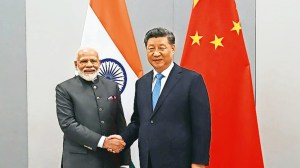India is among the fastest-growing large economies of the world largely driven by the Central government’s elevated expenditure on infrastructure development.
While this government capital expenditure has spurred the growth rate, job creation remains a concern with youth unemployment touching 17 per cent, as highlighted by the World Bank. Private investment, measured by private Gross Fixed Capital Formation (GFCF), has been subdued, declining to a four-quarter low of 6.46 per cent in Q4FY24, down from 9.7 per cent in the previous quarter.

The Economic Survey 2023-2024 also highlighted that between FY19 and FY23, the share of private non-financial corporations in overall GFCF increased only by 0.8 percentage points from 34.1 per cent to 34.9 per cent. The survey said that the capex has lifted the productive potential of the economy and it is time for the private sector to “take the baton”.
Story continues below this ad
One key reason for this is the reduced risk appetite from banks for lending to the private sector, which is the economy’s largest job creator. In a potentially worrying trend, S&P Global on Thursday forecasted that year-on-year credit growth is set to decline during the current financial year to 14 per cent, compared to 16 per cent in the previous fiscal year.
Widening Credit-Deposit Gap
A healthy credit growth rate is essential to maintain economic momentum, especially in an economy such as India where bank credit is a key component. However, for banks to extend credit, deposits must grow in tandem. But banks are currently experiencing a deposit crunch, which is limiting their ability to extend credit. This has led to a widening gap between bank deposits and credit growth, resulting in the worst deposit crunch in two decades.
A treasury research report by HDFC Bank released Thursday highlighted that over the past two years, deposit growth has averaged 11.1 per cent year-on-year, compared to 16.8 per cent credit growth. The report notes that similar periods of slower deposit growth relative to credit growth were observed during 2018-2019, 2011-2013, and 2004-2007, all of which coincided with central bank rate hike cycles.
Current and savings accounts (CASA) – the banks’ primary low-cost funding sources, account for 41 per cent of total deposits, down from 43 per cent last year. Expressing worry over the declining CASA, former Department of Financial Services (DFS) Secretary Vivek Joshi had told the Indian Express in July that CASA should not fall below 40 per cent.
Story continues below this ad
India lagging behind Asian peers
The Reserve Bank of India Governor Shaktikanta Das had, in July, raised concerns over slower deposit mobilisation compared to credit growth stating that as it may create structural liquidity issues. The Governor said that households and consumers, who traditionally rely on banks for parking or investing their savings, are increasingly turning to the capital markets and other financial intermediaries.
A cross-country analysis by HDFC Bank also shows that India had lower credit to GDP for the current per capita income level when compared to other Asian peers such as Thailand, Malaysia, China. The report said that over the medium-term, stricter Liquidity Coverage Ratio (LCR) as suggested in the new draft guidelines could impede credit growth as higher regulatory requirements reduce the amount of lendable deposits.
Meanwhile, S&P Global also said that “regulatory actions to tame unsecured lending” are also slowing credit growth. The RBI recently increased risk weights for unsecured loans which has moderated loan growth in this segment in recent months.
Changing investment habit
The slowdown in deposit growth comes amid an outflow of household savings from banks to capital markets. Following the Covid-19 pandemic, the Indian capital markets have seen a meteoric rise. However, economists say that the shift in households’ saving behaviour towards alternative saving instruments have not alone lowered bank deposits as a move to alternate saving instruments would still imply that the money finds its way into bank deposits.
Story continues below this ad
“A shift in the savings portfolio of a household alone does not lead to a fall in deposits. It does, however, change the composition of deposits – for instance, a shift to CASA from term deposit or a move towards shorter tenure term deposits compared to longer tenure. This in turn could have an adverse impact on the money multiplier and the deposit creation process,” HDFC Bank said.
The banks’ researchers said that low government spending in the run up to the election has also exaggerated the deposit problem in recent months. Government spending remained low in the run up to the elections over the last few months and this led to an increase in government cash balances with the RBI – that rose to a high of Rs 4.4 lakh crore in January 2024 and was above Rs 4 lakh crore in May 2024.
‘Private sector investment cycle is gaining momentum’
S&P Global has said that there are “initial signs” that the private sector investment cycle is gaining momentum. Government investment in infrastructure and the concomitant revival of the housing sector are crowding in private investments in linked sectors such as steel and cement, it said. However, the broad based recovery is yet to happen.
Notably, this is despite the two crucial interventions by the government. The government had cut the tax rates for corporations in September 2019 from 30 per cent to 22 per cent and introduced the Production Linked Investment (PLI) scheme. But as per the 2024-25 Budget document, the share of government revenue from income tax at 19 per cent turned out to be more than 17 per cent that corporates contributed.
































